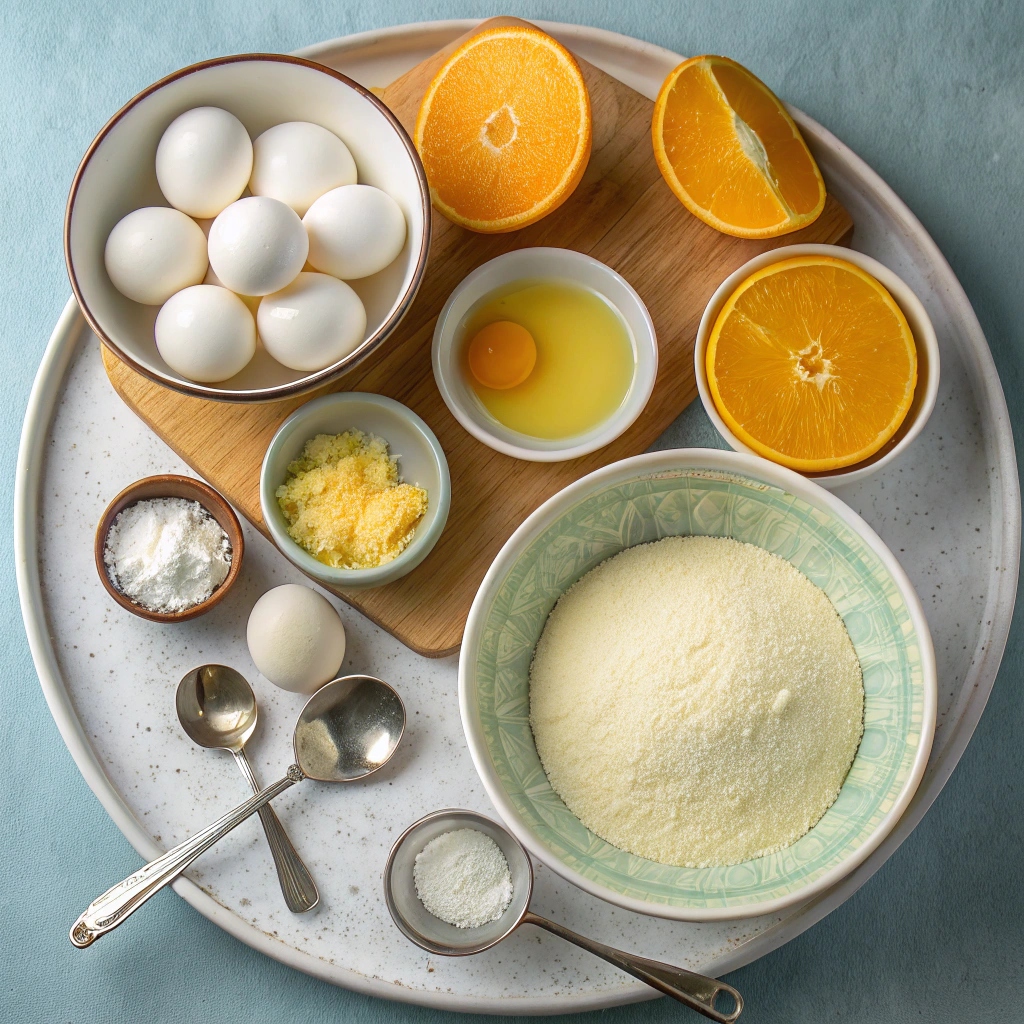Traditional Italian Easter Bread, or Pane di Pasqua, is a celebration of spring in every bite. This soft, golden loaf is enriched with butter and eggs, offering a tender crumb and a subtly sweet flavor. Infused with citrus zest and studded with colorful eggs, it’s as beautiful as it is delicious.
The long proofing time, over 14 hours, ensures a light, airy texture that’s worth the wait. Perfect for sharing with loved ones, this bread brings warmth and tradition to your Easter table.
With just over an hour of hands-on prep and 35 minutes of baking, this recipe is surprisingly simple yet deeply rewarding. The aroma of freshly baked bread, mingling with hints of orange and vanilla, will fill your kitchen with joy.
Whether enjoyed warm from the oven or toasted the next day, its rich, buttery flavor and festive presentation make it a standout centerpiece. Embrace the spirit of the season with this timeless Italian classic.
Ingredients for Traditional Italian Easter Bread (Pane di Pasqua)

- For the Dyed Eggs:
- 6 white eggs, uncooked
- 6 teaspoons vinegar
- Gel food coloring, of your choice
- For the Sponge:
- 1 cup (5 oz/142 g) all-purpose flour
- ⅛ teaspoon instant yeast
- ½ cup (4 fl oz/120 ml) water, at room temperature
- For the Dough:
- 2 cups (10 oz/284 g) all-purpose flour
- ⅓ cup (2 ½ oz/71 g) granulated sugar
- 2 teaspoons instant yeast
- 1¼ teaspoons salt
- ¼ cup (2 oz/57 g) butter, softened
- 2 large eggs, at room temperature
- 1 large egg yolk, at room temperature
- ½ teaspoon Fiori di Sicilia Citrus Flavor* (or substitute with vanilla extract)
- ¼ teaspoon aniseed
- Zest of 1 orange
- Egg wash (1 egg beaten with 1 tablespoon water)
- For the Glaze:
- 1 cup (4 oz/115 g) powdered sugar, sifted
- 2-3 tablespoons milk (or orange juice for added flavor)
- Sprinkles, for decoration
Step-by-Step Instructions
- The Day Before: Dye the Eggs
- Fill six small bowls with 1 cup (8 fl oz/240 ml) of water each. Add 1 teaspoon of vinegar to each bowl.
- Add a few drops of different food coloring to each bowl until you achieve your desired colors.
- Place an egg in each bowl and turn it in the colored water for 5-10 minutes, until the eggs take on the color.
- Transfer the eggs to a wire rack to dry completely, then refrigerate until needed. (This can be done up to 2 days in advance.)
- Make the Sponge
- In a medium bowl, combine 1 cup flour, ⅛ teaspoon yeast, and ½ cup water. Mix well.
- Cover the bowl with plastic wrap and let it sit on the counter overnight.
- The Next Day: Make the Dough
- Using a stand mixer fitted with a dough hook, mix the sponge with all dough ingredients: 2 cups flour, sugar, yeast, salt, butter, eggs, yolk, Fiori di Sicilia (or vanilla), aniseed, and orange zest.
- Mix on low speed for about 10 minutes, until the dough is soft, smooth, and clears the sides of the bowl but sticks to the bottom. Add a touch more flour only if absolutely necessary.
- Transfer the dough to an oiled bowl, cover, and let rise in a warm place until doubled in size, about 2 hours.
- Shape the Dough
- Line a baking sheet with parchment paper.
- Divide the dough in half and roll each piece into a 20-inch (50 cm) long log.
- Twist the logs together and bring the ends together to form a circle.
- Transfer the wreath to the prepared baking sheet, cover lightly with plastic wrap, and let rise again until doubled, about 1 hour.
- Bake the Bread
- Preheat the oven to 375°F (190°C) towards the end of the rising time.
- Carefully pull the rope strands apart and nestle the dyed eggs into the wreath.
- Brush the entire wreath with egg wash.
- Bake for 15 minutes, then lower the heat to 350°F (180°C) and bake for another 20 minutes. Tent with foil if the bread begins to overbrown.
- Remove from the oven and let cool completely.
- Make the Glaze
- In a small bowl, combine powdered sugar and 2 tablespoons of milk. Add more milk or orange juice, a few drops at a time, for a thinner consistency.
- Drizzle the glaze over the cooled bread and decorate with sprinkles. Let the glaze dry before serving.
Perfect Pairings: Serving Suggestions
Traditional Italian Easter Bread is a showstopper on its own, but it pairs beautifully with a cup of espresso or a glass of sweet dessert wine like Moscato. For a festive brunch, serve it alongside fresh fruit, a dollop of whipped cream, or a drizzle of honey. It’s also delightful with a spread of softened butter or a smear of orange marmalade for an extra citrusy kick.
Storage Secrets: Keeping It Fresh
This bread is best enjoyed the day it’s made, but if you have leftovers, store them in an airtight container at room temperature for up to 2 days. To refresh it, lightly toast slices in the oven at 300°F (150°C) for 5-7 minutes. Note: The dyed eggs are for decoration only and should not be eaten after baking.
Time-Saving Tips for Busy Bakers
If you’re short on time, skip the overnight sponge step and use 2 ¼ teaspoons of instant yeast directly in the dough. You can also prepare the dyed eggs up to 2 days in advance. For a quicker rise, place the dough in a slightly warmed oven (turned off) with a bowl of hot water to create a warm, humid environment.
Recipe Variations: Make It Your Own
Feel free to customize this recipe to suit your tastes! Swap the aniseed for cardamom or cinnamon for a different flavor profile. You can also use lemon zest instead of orange for a tangier twist. For a nutty addition, fold in ½ cup of chopped almonds or pistachios into the dough before shaping.
Essential Equipment for Success
To make this recipe easier, ensure you have a stand mixer with a dough hook for kneading the dough. A parchment-lined baking sheet is a must for shaping and baking the bread. For the glaze, a fine-mesh sieve will help sift the powdered sugar smoothly, and a pastry brush is perfect for applying the egg wash evenly.
Traditional Italian Easter Bread (Pane di Pasqua)
Ingredients
For the Dyed Eggs
- 6 white eggs, uncooked
- 6 teaspoons vinegar
- Gel food coloring, of your choice
For the Sponge
- 1 cup all-purpose flour 5 oz/142 g
- ⅛ teaspoon instant yeast
- ½ cup water, at room temperature 4 fl oz/120 ml
For the Dough
- 2 cup all-purpose flour 10 oz/284 g
- ⅓ cup granulated sugar 2 ½ oz/71 g
- 2 teaspoons instant yeast
- 1¼ teaspoons salt
- ¼ cup butter, softened 2 oz/57 g
- 2 large eggs, at room temperature
- 1 large egg yolk, at room temperature
- ½ teaspoon Fiori di Sicilia Citrus Flavor
- ¼ teaspoon aniseed
- Zest of 1 orange
Egg wash
For the Glaze
- 1 cup powdered sugar, sifted 4 oz/115 g
- 2-3 tablespoons milk
- Sprinkles, for decoration
Instructions
- The Day Before Dye the Eggs
- Fill six small bowls with 1 cup (8 fl oz/240 ml) of water. Add 1 teaspoon of vinegar to each bowl and add a few drops of different food coloring to each bowl until you get your desired colors.
- Add an egg to each bowl and turn in the colored water for 5-10 minutes, until the eggs take on the color you want.
- Transfer to a wire rack to allow the eggs to dry completely, then refrigerate until needed. This can be done up to 2 days in advance.
- Make the Sponge
- In a medium bowl, combine the flour, yeast and water and cover with plastic wrap. Let sit on the counter overnight.
- The Next Day Make the Dough
- The next day, using a stand mixer fitted with a dough hook, mix the sponge with all of the dough ingredients: flour, sugar, yeast, salt, butter, eggs, yolk, vanilla extract, orange oil, aniseed and orange zest on low speed for about 10 minutes, until you have a very soft, smooth dough that clears the sides of the bowl but remains stuck to the bottom. If absolutely needed, add a touch more flour, but use as little as possible.
- Transfer to an oiled bowl, cover and let rise in a warm place until doubled in size, about 2 hours.
- Shaping the Dough
- Line a baking sheet with parchment paper.
- Divide the dough in half and roll each piece into a 20-inch (50 cm) long log. Twist the logs together and then bring the ends together to form a circle.
- Carefully transfer to the prepared baking sheet and lightly cover with plastic wrap. Let rise again until doubled, about 1 hour.
- Bake the Bread
- Towards the end of the rising time, preheat the oven to 375°F (190°C).
- Carefully pull the rope strands apart and nestle the eggs in the wreath, then brush all over with egg wash.
- Bake for 15 minutes, then lower the heat to 350°F (180°C) and bake for another 20 minutes. If the bread begins to overbrown, then tent it with foil for the remainder of the bake time. Remove from the oven to cool completely.
- Make the Glaze
- In a small bowl, combine the powdered sugar and 2 tablespoons of milk. If you would like a thinner glaze, add a little more orange juice, a few drops at a time, until you get the consistency you want. Drizzle the bread with the glaze and add the sprinkles on top. Let the glaze dry before serving.
- This is best the day it is made but you can store the leftovers in an airtight container at room temperature for up to 2 days. Note we do not recommend eating the eggs.
